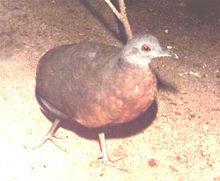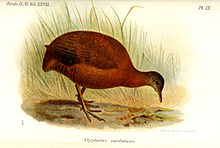| Brown tinamou | |
|---|---|
 | |
| Scientific classification | |
| Kingdom: | Animalia |
| Phylum: | Chordata |
| Class: | Aves |
| Order: | Tinamiformes |
| Family: | Tinamidae |
| Genus: | Crypturellus |
| Species: | C. obsoletus |
| Binomial name | |
| Crypturellus obsoletus | |
| Subspecies[2] | |
| C. o. obsoletus | |
The brown tinamou (Crypturellus obsoletus) is a brownish ground bird found in humid lowland and montane forest in tropical and subtropical South America.[3]
Taxonomy

All tinamous are usually treated in a single family (Tinamidae) and, contrary to traditional classifications, they are embedded within the group known as ratites, most closely related to the extinct moa of New Zealand. However, unlike ratites (ostriches, rheas, moa, kiwis, emus, cassowaries & elephantbirds), tinamous are capable of flight, although in general, they are not strong fliers. Different ratite lineages evolved separately from ancient flying birds, and tinamous are thought to most closely resemble these ancestral ratites.[4]
Subspecies
Its distribution is highly disjunct and the subspecies, which quite probably represent more than one species, are distributed as follows:
- C. o. obsoletus, the nominate race, occurs in the Atlantic forest in southeastern Brazil, eastern Paraguay and Misiones, Argentina.[5]
- C. o. griseiventris occurs throughout the valley of Rio Tapajós, Brazil; southwestern Pará, southeastern Amazonas, and central Mato Grosso.[5]
- C. o. hypochraceus occurs in upper Rio Madeira valley in central Rondônia, Brazil.[5]
- C. o. punensis occurs in the Yungas of central Bolivia and extreme southeastern Peru.[5]
- C. o. traylori, Traylor's tinamou, occurs in the Marcapata Valley of central Cusco, southeastern Peru;[5] sometimes treated as a separate species.
- C. o. ochraceiventris occurs along the east Andean slopes in central Peru; Huanuco, Pasco, Junín, northern Ayacucho, and Cusco.[5]
- C. o. castaneus occurs east of the Andes in northern Peru, Ecuador, and Colombia;[5] sometimes treated as a separate species.
- C. o. knoxi occurs in sub-tropical northwestern Venezuela.[5]
- C. o. cerviniventris occurs in northern Venezuela.[5]
Additionally, there are records from north Mato Grosso in Brazil, but it remains unclear which subspecies is involved. Most subspecies occur in highlands, but hypochraceus, griseiventris, and the southern populations of the nominate taxon occur in lowlands. It is uncommon to rare in most of its range, but commoner in southeastern Brazil, where it is the most frequently encountered member of its genus.
Etymology
Crypturellus is formed from three Latin or Greek words. kruptos meaning covered or hidden, oura meaning tail, and ellus meaning diminutive. Therefore, Crypturellus means small hidden tail.[6]
Description
The brown tinamou is approximately 25 to 30 cm (9.8–11.8 in) in length and it weighs about 350 to 550 g (12–19 oz). Depending on the subspecies involved, the upperparts vary from dark sooty-brown to bright chestnut and the underparts, which usually are paler than the upperparts, vary from chestnut to light ochraceous. The subspecies griseiventris is unique in having pale buff-grey underparts. All subspecies can be separated from the superficially similar little tinamou by the greyish (rather than whitish) throat. Females are typically larger and more rufescent than the males.
Behavior
As other tinamous of its genus, it is a shy, ground-dwelling species, which usually is encountered singly or in pairs. It feeds on fruits, insects, and seeds. The female lays 4-5 deep pink to dark glossy brown eggs on the ground; typically in a small depression at the base of a tree. Its song consists of loud, high-pitches whistles, but exact structure and timbre vary over its range.
Range and habitat
The brown tinamou is located in northern Venezuela, Colombia, Ecuador, Peru, northern and southern Brazil, extreme northeastern Argentina, eastern Bolivia, and eastern Paraguay.[5] They may also be in Uruguay.[1]
They live in tropical and sub-tropical moist lowland and montane forests, preferring elevations between 1,300 to 2,900 m (4,300–9,500 ft).[3]
Conservation
The IUCN classifies the brown tinamou as Least Concern,[1] with an occurrence range of 1,700,000 km2 (660,000 sq mi).[3]
Footnotes
References
- BirdLife International (2008). "Brown Tinamou - BirdLife Species Factsheet". Data Zone. Retrieved 9 February 2009.
- Brands, Sheila (14 August 2008). "Systema Naturae 2000 / Classification, Crypturellus obsoletus". Project: The Taxonomicon. Retrieved 9 February 2009.
- Clements, James (2007). The Clements Checklist of the Birds of the World (6th ed.). Ithaca, NY: Cornell University Press. ISBN 978-0-8014-4501-9.
- Davies, S. J. J. F. (2002) Ratites and Tinamous ISBN 0-19-854996-2
- Davies, S.J.J.F. (2003). "Tinamous". In Hutchins, Michael (ed.). Grzimek's Animal Life Encyclopedia. 8 Birds I Tinamous and Ratites to Hoatzins (2nd ed.). Farmington Hills, MI: Gale Group. pp. 57–59. ISBN 0-7876-5784-0.
- Gotch, A. F. (1995) [1979]. "Tinamous". Latin Names Explained. A Guide to the Scientific Classifications of Reptiles, Birds & Mammals. New York, NY: Facts on File. p. 183. ISBN 0-8160-3377-3.
- Hilty, (2003) Birds of Venezuela ISBN 0-691-09250-8
External links
- FAUNA Paraguay A complete online guide to Paraguayan fauna
- BirdLife Species Factsheet
- Brown Tinamou videos, photos & sounds on the Internet Bird Collection
